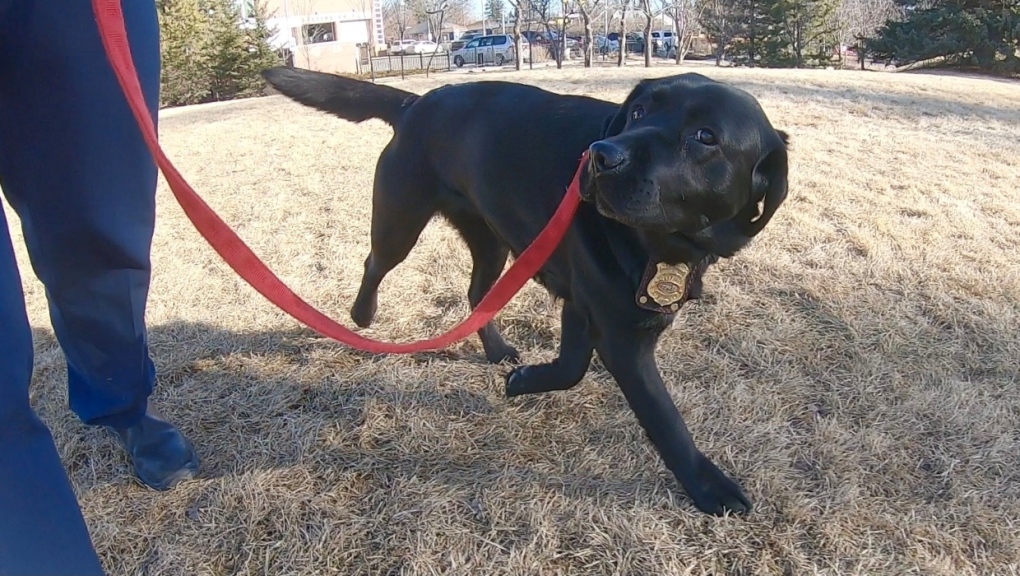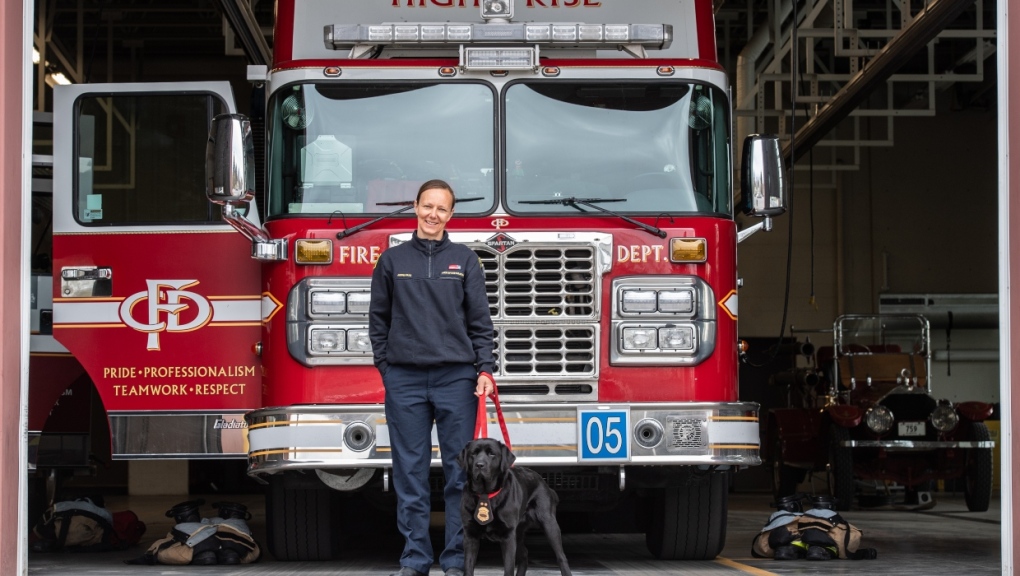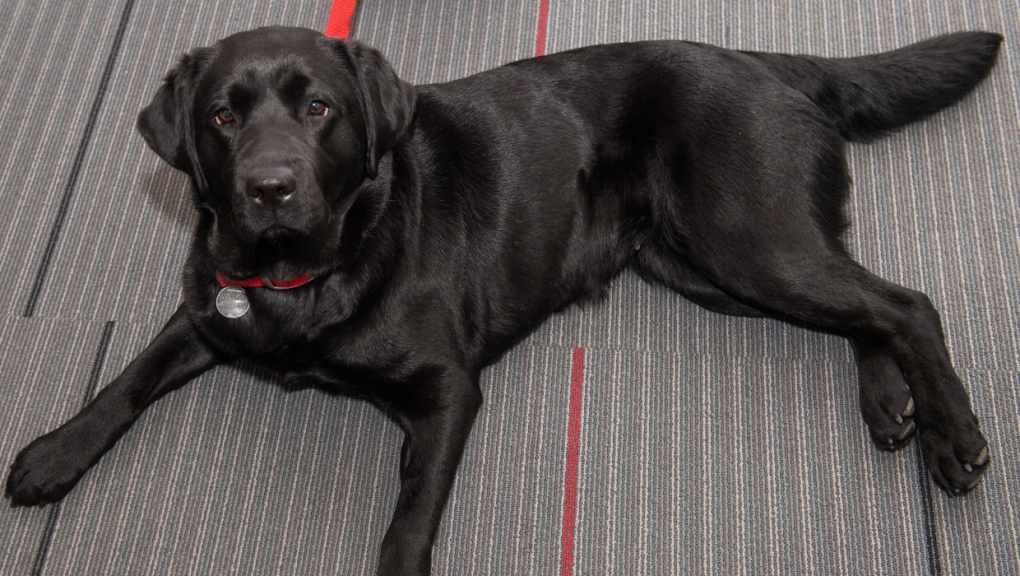Dogs with jobs: Meet the Calgary Fire Department's accelerant detection dog
At just five-years-old, Willow is easily the youngest member of the Calgary Fire Department.
Despite her youth, the black labrador retriever has already worked on 120 investigations in the past two years.
Willow's partner is fire investigator Jodie Grisdale. They've been together for the last two-and-a-half years.
"Willow is an accelerant detection dog and we'll use her in fires that we deem potentially suspicious for an arson," said Grisdale. "But she's also extremely valuable when we don't really have a source of why the fires start, she can help us to rule out that there isn't any accelerant use to start the fire."
 Willow the accelerant detection dog. Willow is the fourth dog to work for the fire department. Velvet was the first, followed by Honey, then Gibbs. The dogs trypically work five to 10 years before retirement.
Willow the accelerant detection dog. Willow is the fourth dog to work for the fire department. Velvet was the first, followed by Honey, then Gibbs. The dogs trypically work five to 10 years before retirement.
"She comes to work with me spends her shift here in the fire hall, and then at the end of shift I get to take her home with me and she lives as a normal dog at home with my family," said Grisdale.
Willow was first being trained to help people with disabilities but she didn't pass her testing. She met up with Grisdale in New Hampshire where the two spent 200 hours in a course that trained the dog to sniff out minute traces of accelerants like gasoline and lighter fluid that may have been used to start a fire.
"She had already been imprinted on ignitable liquids, so really that month was spent me learning to work with her," said Grisdale. "She really taught me the ropes, and then we graduated, we got our certification and we came home and we hit the ground running."
Accelerant detection canines like Willow can discriminate between liquid accelerants and the chemical gasses at a fire scene with greater accuracy than electronic devices.
 Jodie Grisdale and Willow the accelerant detection dog are shown in a handout photo from the Calgary Fire Department. According to the American Kennel Club, a dog's nose is at least 100,000 times more sensitive than a human's. Not only does it have more olfactory receptors, but the part of the brain that processes smells is seven times larger in dogs than in humans.
Jodie Grisdale and Willow the accelerant detection dog are shown in a handout photo from the Calgary Fire Department. According to the American Kennel Club, a dog's nose is at least 100,000 times more sensitive than a human's. Not only does it have more olfactory receptors, but the part of the brain that processes smells is seven times larger in dogs than in humans.
"One of the retired handlers said to me, 'really learn to trust your dog,'" said Grisdale. "That's been one of the biggest lessons. I'm an animal lover, a dog lover, but I get what he means, those dogs know their job."
Carol Henke is the department's public information officer and says Willow is another tool in CFD's toolbox to determine the cause of a fire.
"Willow increases the efficiency and the effectiveness of investigations," said Henke. "Not only that, what an amazing ambassador for the fire department, I mean, you can tell when Willow's in the office at fire headquarters because you hear these 'oohs' and 'ahhs' and everyone's voices get higher."
 Willow the accelerant detection dog is shown in a handout photo from the Calgary Fire Department. Grisdale has been with CFD for 15 years and started fighting fires, moved into fire inspector and now is a fire investigator with Willow.
Willow the accelerant detection dog is shown in a handout photo from the Calgary Fire Department. Grisdale has been with CFD for 15 years and started fighting fires, moved into fire inspector and now is a fire investigator with Willow.
"I could never have dreamed of being with the Calgary Fire Department and working with a canine," she said. "That, to me, is the ultimate dream job, and to be in this position is a real honor, I feel very fortunate."
CTVNews.ca Top Stories

Inflation is down, wages are up. Why are Canadians still frustrated with the economy?
The federal finance minister has been taking every opportunity to remind frustrated Canadians that after a bumpy pandemic recovery, the nation's economy is actually doing a lot better.
Australian foreign minister raises allegations with Indian counterpart of targeting Sikhs in Canada
Australia's foreign minister said Tuesday she raised allegations with her Indian counterpart that India has targeted Sikh activists in Canada.
'Be ready for both': Canadians prepare for any outcome as Americans head to the polls
Millions of Americans are heading to the polls Tuesday as a chaotic presidential campaign reaches its peak in a deeply divided United States, where voters in only a handful of battleground states will choose the country’s path forward.
Months after VRBO booking, Taylor Swift fan told home 'not available' during Vancouver concert
A frustrated Taylor Swift fan is speaking out after being pushed from a short-term rental she booked for the upcoming Vancouver leg of the superstar’s Eras Tour.
Canada Post, union, still disagree over weekend delivery following weekend talks
Canada Post and the union representing its workers are commenting on how weekend talks for a new contract went, with the employer calling them less productive than they'd hoped and the union claiming their employer is focused on flexibility to deliver parcels at the lowest possible cost.
Trudeau and Harris? Poilievre and Trump? Here's who Canadians think would work best with: survey
As Americans prepare to elect their next president on Tuesday, new data from the Angus Reid Institute suggests Canadians hold differing views as to which federal party leaders would be best suited to deal with either Donald Trump or Kamala Harris.
B.C. port employers launch lockout at terminals in labour dispute with workers
Employers at British Columbia ports say they are going ahead with locking out more than 700 foremen across the province after strike activities from union members began.
Boeing factory strike ends as workers vote to accept contract
Factory workers at Boeing voted to accept a contract offer and end their strike after more than seven weeks, clearing the way for the aerospace giant to resume production of its bestselling airliner and generate much-needed cash.
UN refugee chief says reducing refugee targets is wise if it prevents backlash
The head of the United Nations refugee agency says it is wise of Canada to scale back the number of new refugees it plans to resettle if that helps stabilize the housing market and prevents backlash against newcomers.


































